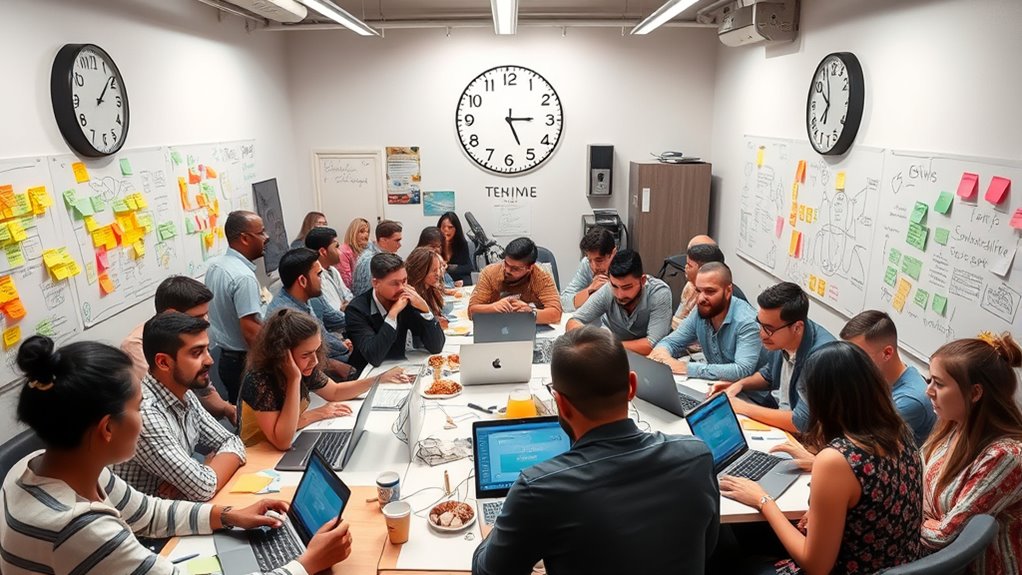To brainstorm project ideas quickly in a hackathon, gather your team and create a collaborative environment. Encourage everyone to share all ideas, even the wild ones, to boost creativity. Focus on generating a broad pool of concepts and use hands-on techniques like prototyping to visualize top ideas. Don’t forget to validate your ideas by evaluating their real-world impact and feasibility. By maintaining high energy and enthusiasm, you’ll set the stage for a successful project ahead. There’s more to explore, so keep going!
Key Takeaways
- Assemble a diverse team to leverage different perspectives and spark creative thinking during brainstorming sessions.
- Foster an open environment where all ideas, no matter how unconventional, are welcomed and discussed.
- Utilize techniques like mind mapping or rapid ideation to generate a large pool of ideas quickly.
- Focus on real-world problems to guide brainstorming and ensure ideas have practical applications and user benefits.
- Evaluate and refine ideas collaboratively, using critical questions to assess feasibility and impact before moving forward.

When you think about hackathons, you might picture a frenzy of coding and creativity, but the real magic often begins with ideation. This initial phase sets the stage for everything that follows. You’ll want to gather your team and immerse yourself in brainstorming sessions, where collaboration becomes essential. It’s during these moments that diverse perspectives can ignite innovative ideas, allowing everyone to contribute their unique insights. You’ll find that some of the best concepts emerge from the synergy of team collaboration, so don’t hesitate to share the floor.
To kick off your ideation process, start with a brainstorming session. Encourage everyone to throw out ideas, no matter how wild they may seem. Sometimes the most unconventional thoughts can lead to groundbreaking solutions. As you generate a pool of ideas, focus on creating an open environment where everyone feels comfortable sharing. This atmosphere fosters creativity and helps you open up your team’s full potential. Remember, it’s not just about individual brilliance; it’s about harnessing collective creativity.
Kick off your ideation with brainstorming—embrace wild ideas and foster a creative environment for collective brilliance.
Once you’ve gathered a list of potential project ideas, it’s time to move into idea validation. You need to assess which concepts have the most merit. Start asking critical questions: Does this idea solve a real problem? Is there an audience that would benefit from it? By systematically evaluating your ideas, you’ll narrow down your options and identify the ones that are not only feasible but also have the potential for impact. This phase is essential, as it helps you avoid wasting valuable time and resources on concepts that don’t resonate with users.
Don’t forget to involve your team in this validation process. Their insights can provide a different perspective on the viability of each idea. You might even consider creating basic prototypes or mock-ups to visualize the concepts better. This hands-on approach can further refine your ideas and clarify which ones are worth pursuing.
As you finalize your project idea, keep the energy high and maintain enthusiasm within your team. This positive momentum will carry you through the next phases of your hackathon journey. With a solid idea in hand, you’re ready to shift into development, armed with the confidence that your concept has been thoroughly vetted. Embrace the collaborative spirit of your team and prepare to create something amazing!
Frequently Asked Questions
How Do I Form a Team for a Hackathon?
To form a team for a hackathon, start by evaluating team dynamics and skill matching. Reach out to friends or colleagues whose skills complement yours, like developers, designers, or marketers. Utilize social media and hackathon forums to connect with others interested in participating. Once you’ve gathered a group, discuss your strengths and weaknesses openly to guarantee a balanced team. Remember, good communication and collaboration are key to succeeding together during the event!
What Types of Projects Are Typically Successful at Hackathons?
Innovative applications often shine next to practical solutions at hackathons. You’ll find that projects combining creativity with real-world utility capture attention. Think of an app that enhances daily life while showcasing cutting-edge technology. For instance, a platform that connects local farmers to consumers not only solves a problem but also promotes sustainability. Focus on user needs, and you’ll set your team up for success, creating impactful projects that resonate with judges and participants alike.
How Long Should a Hackathon Project Ideally Be?
A hackathon project should ideally be scoped to fit within a 24 to 48-hour timeframe. This allows you to manage your time effectively and focus on delivering a polished prototype. Narrowing your project scope helps you prioritize key features and avoid getting overwhelmed. With solid time management, you’ll make the most of your hours, ensuring you can present a functional and impressive project by the end of the event.
Can I Use Existing Code or Libraries During a Hackathon?
Imagine a chef who can use any ingredient from the pantry. You can definitely use existing code or libraries during a hackathon! Embracing open source and code reuse not only saves time but also enhances your project’s quality. Just like a chef mixes flavors for the best dish, you can blend existing solutions to create something innovative. So, delve into those libraries and start cooking up your next big idea!
What Are Common Prizes for Winning Hackathon Projects?
Common prizes for winning hackathon projects often include cash, tech gadgets, gift cards, and mentorship opportunities. You might find award types like Best Overall Project, Best Use of Technology, or Most Innovative Solution. Prize categories can also focus on specific themes, such as social impact, sustainability, or health tech. These rewards not only recognize your hard work but also provide valuable resources to help you further develop your project.
Conclusion
In the whirlwind of a hackathon, remember that brainstorming project ideas is like fishing in a vast ocean—there’s always a catch waiting for you. Don’t hesitate to cast your net wide; inspiration can strike when you least expect it. Engage with your teammates, let creativity flow, and don’t shy away from wild ideas. As you plunge into this collaborative adventure, trust that the best projects often emerge from the most unexpected places. Happy hacking!









